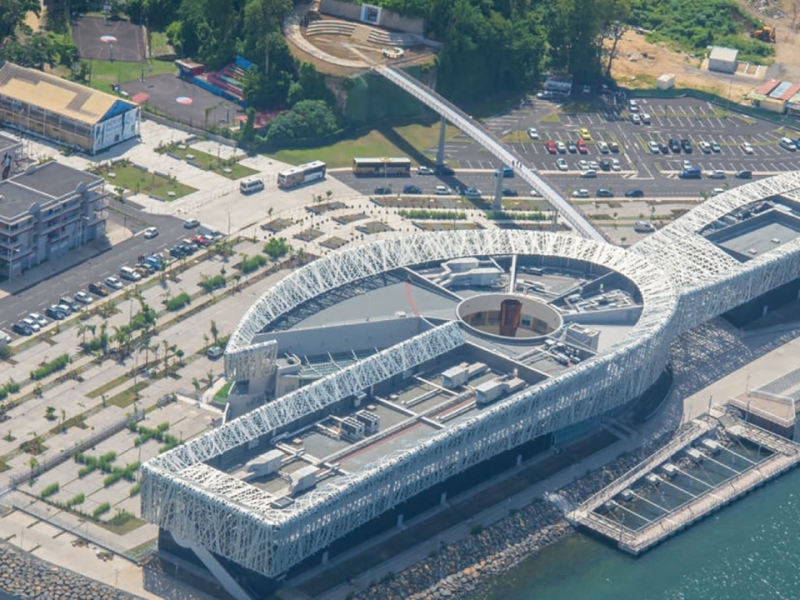Memorial ACTe
In Point-a-Pitre, Memorial ACTe is a cultural center dedicated to the slave trade's history. It is part of UNESCO's Slave Route Project, which tells the tales of individuals who were forced into slavery in the Guadeloupe Islands, as well as the obstacles and problems they faced. This museum honors individuals who have suffered and promotes positive dialogue about this tragic period in history.
As a representative and memorial for the slave trade and slavery, the Memorial ACTe Center in the Caribbean was inaugurated on May 10, 2015, at the initiative of the Guadeloupe region, with the aim of contributing through Consciousness, culture, and creativity are close to historical wounds, the process of building Guadeloupean society, as well as in the Caribbean and America.
The museum's founding ideas include the goal of offering intellectual tools to combat social repercussions and enslavement, such as racism, social exclusion, inequality, and modern human rights violations, by turning the act of remembrance into a method of establishing a new society.
The museum is made up of two buildings paved with black granite, surrounded by an anodized aluminum maze with majestic lights at night. Figuratively speaking, the museum is like a black box containing a past in which the collective memory has been partially rebuilt. The constellation of quartz fragments on the black face represents millions of lost slave souls, commemorating slavery and the victims of the slave trade.
Memorial ACTe is divided into three sections: the first permanent display area, where knowledge, a second location for exchanging and popularizing ideas, and the third room for contemplation consisting of an 11.5-meter-long, 275-meter-long bridge offering a beautiful walk between the sky and earth, with views of the city of Pointe-à-Pitre, Basse-Terre, and the sea, and also lead visitors to "Morne Mémoire", a garden of about 2.2 hectares where the owner of the house, a vinegar cellar, and a slave cemetery were located.
The Memorial ACTe's permanent display covers not just slavery and the transatlantic slave traffic, but also the history of slavery in general, from ancient times to the current day. Visitors are immersed in the past and relive history in a 1700 m2 area, owing to 37 textbook modules divided into six archipelagos, as well as a gallery of historic portraits. All works and materials on display in the museum have been built and designed by the Guadeloupe Regional Council for the past three years. For every visitor to have the best experience, Memorial ACTe's permanent exhibition offers a journey through time, animated by cutting-edge technologies such as large screens, and multi-experiences. sense. Specifically, from the construction of the Americas to the contemporary period, Memorial ACTe also has a massive database with between 6,000 and 8,000 Guadeloupe family trees. As a result, descendants of Guadeloupe slaves will be allowed to research their forefathers. With so many valuable works and documents, Memorial ACTe deserves to be one of the 4 Most Beautiful Historical Sites in Guadeloupe.
The museum is not only outstanding but also beautiful and innovative, completely consistent with the criteria set by the Council of Europe. Originally intended as a memorial, the museum not only became a lively, dynamic place to commemorate the transatlantic slave trade and intercontinental slavery from the continent of Africa, and America to Europe. This is also a place to commemorate the resilience of slaves who suffer from persecution and hardship. That image fosters tolerance and opens up beautiful prospects in creative ways for the future. In 2017, Memorial ACTe (MACTe) was honored by the Cultural Committee of the Council of the European Parliament (PACE) with the 2017 Museum of the Council Award as the Center for Human Trafficking Expression and Memory and the Slaves of the Caribbean, Guadeloupe (France).
Since 2020, the regional space is dedicated to the display of historical information, knowledge, and research, for residents, tourists, students, and researchers. The Memorial ACTe was maintained as a powerful iconic site, recreating its historical time and exhibiting contemporary manifestations. Despite the focus on the Guadeloupe archipelago and its Caribbean environment, the problem of the slave trade is still being reinterpreted in today's global context.
Here, visitors have a total visit time of 2 to 4 hours to explore and learn about this museum. The late opening hours also make Memorial ACTe a lively arts hub and meeting place for locals. Through six archipelagos made up of 39 islands, upon arrival, you will explore a time-leading journey from antiquity to 1492, from post-Colombian slavery to its abolition, from colonial times to independence until today. Along with that, audio guides are available for the tour in 4 languages: French, Creole, English, and Spanish.





